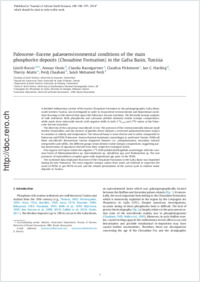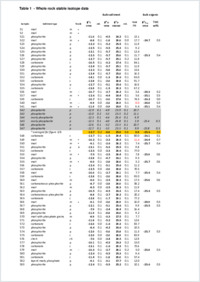Paleocene–Eocene palaeoenvironmental conditions of the main phosphorite deposits (Chouabine Formation) in the Gafsa Basin, Tunisia
- Kocsis, László Institute of Earth Sciences, University of Lausanne, Switzerland - Geoscience Department, Universiti of Brunei Darussalam - UBD, Brunei Darussalam
- Ounis, Anouar Faculté des Sciences de Tunis, Université de Tunis El Manar, Tunisia
- Baumgartner, Claudia Institute of Earth Sciences, University of Lausanne, Switzerland
- Pirkenseer, Claudius Department of Earth Sciences, University of Fribourg, Switzerland
- Harding, Ian C. Ocean & Earth Science, University of Southampton, National Oceanography Centre, UK
- Adatte, Thierry Institute of Earth Sciences, University of Lausanne, Switzerland
- Chaabani, Fredj Faculté des Sciences de Tunis, Université de Tunis El Manar, Tunisia
- Neili, Salah Mohamed Compagnie des Phosphates de Gafsa, Direction de Géologie, Métlaoui, Tunisia
-
20.08.2014
Published in:
- Journal of African Earth Sciences. - 2014, vol. 100, p. 586–597
English
A detailed sedimentary section of the marine Chouabine Formation in the palaeogeographic Gafsa Basin, south-western Tunisia, was investigated in order to characterize environmental and depositional conditions focusing on the interval that spans the Paleocene–Eocene transition. We did stable isotope analyses of bulk sediments. Both phosphorite and carbonate yielded relatively similar isotopic compositions; while marls show observable trends, with negative shifts in both δ13Cinorg and δ18O values at the Paleocene–Eocene transition.The diversity of the calcareous microfossils is low. The presence of few environmentally tolerant small benthic foraminifera and the absence of planktic forms indicate a restricted palaeoenvironment subject to variation in salinity and temperature. The ostracod fauna is more diverse and is rather comparable to Paleocene and PETM (Paleocene–Eocene thermal maximum) assemblages in northwest Tunisia. While all these microfossils demonstrate various diagenetic features (i.e., phosphatization, secondary mineral overgrowths and infills), the different groups retain distinct stable isotopic compositions, suggesting partial preservation of signatures derived from their respective ecological niches.Few organic-rich layers below the negative δ13C shift yielded dinoflagellate assemblages with the common forms of Adnatosphaeridium sp., Operculodinium sp., Spiniferites spp. and Thalassiphora sp. The rare presences of Apectodinium-complex agree with depositional age prior to the PETM.The combined data emphasize that most of the Chouabine Formation in the Gafsa Basin was deposited during the late Paleocene. The most negative isotopic values from marls are believed to represent the onset of PETM or pre-PETM record, and the related perturbation of the carbon cycle in shallow water deposits in Tunisia.
- Faculty
- Faculté des sciences et de médecine
- Department
- Département de Géosciences
- Language
-
- English
- Classification
- Geology
- License
-
License undefined
- Identifiers
-
- RERO DOC 234240
- DOI 10.1016/j.jafrearsci.2014.07.024
- Persistent URL
- https://folia.unifr.ch/unifr/documents/304144
Other files
Statistics
Document views: 122
File downloads:
- pdf: 523
- Supplementary material: 116

